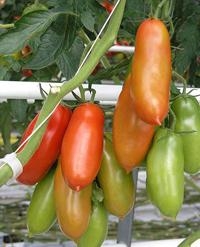By Ken Hodge, Randy Swett, and Eve Werner, Butte County Master Gardeners, May 3, 2013

If you haven’t grown tomatoes before, the best way to start is to narrow down the possibilities by determining the uses for your tomatoes: slicing tomatoes are used on sandwiches and hamburgers; small, sweet cherry-sized tomatoes are perfect for salads and immediate gratification right off the vine; spicier-tasting tomatoes add a kick to salsa; paste tomatoes are best for canning and cooking because they have fewer seeds and less juice; and some varieties are well-suited for sun-drying.
Good slicing tomatoes that do well in our climate include the Beaverlodge Slicer, Aussie, Dinner Plate, Giant Belgium, Aunt Ginney's Purple, Marianna' Peace, Good Old Fashion Red, Momotaro, and Rainbow. Cherry tomatoes include Sugar Lump, Isis Candy, Sun Gold, Black Cherry and White Currant, in addition to the more commonly sold (but nonetheless delicious) Sweet Million and Hundred Million. La Roma & San Marzano make great salsa & are good for shish kebabs. Amish Paste, Costoluto Genovese, San Marzano Ridorta and Red Pear make excellent tomato sauce. Some of the lesser known, interesting & tasty large tomatoes are Pineapple, Marianna's Peace, Kellogg's Breakfast & Brandywine. Pachino & Princepe Borghese are good for making sun-dried tomatoes.
Another characteristic that may influence your choice of tomato plants is whether they are determinate or indeterminate. A determinate tomato plant stops growing when it sets fruit. Their compact size and bushy growth make determinate tomatoes good choices for containers & small space gardening. And if you plan on canning or freezing tomatoes for later use, determinates will be most convenient because they ripen all their fruit at once in a relatively short period. Good examples of determinate tomatoes are La Roma and Beaverlodge Slicer.
Indeterminate tomato varieties (also known as “vining” tomatoes) grow, bloom, and produce fruit continuously until killed by frost, providing a steady supply of ripe fruit throughout the season. With indeterminate tomatoes you will see blossoms, green tomatoes, and ripe tomatoes commingling on a single plant. Indeterminate varieties grow big – six to ten feet tall in the Sacramento Valley. For example, the aforementioned White Currant cherry tomato grows rapidly and spreads extensively in ideal (sunny) conditions. But indeterminate plants can be pruned and staked or caged to control their size and shape. Sturdy supports with wire mesh cylinders or panels will promote healthy growth and reduce damage from pests and sunburn. Don’t prune a determinate tomato much or your harvest will be reduced.
Most tomatoes are indeterminate, especially the interesting heirloom tomatoes which have become more available in the past few years. The strict lines between determinate and indeterminate may become looser with advances in plant breeding (just as the distinctions between floribunda and hybrid tea roses have become less defined). For example, Celebrity is considered a semi-determinate tomato, because it ripens over a broader season than true determinate tomatoes.
There are many tomato varieties to choose from: selecting tomatoes best suited to your eating plans will enhance your gardening (and dining) experience.
Photo: San Marzano Tomatoes